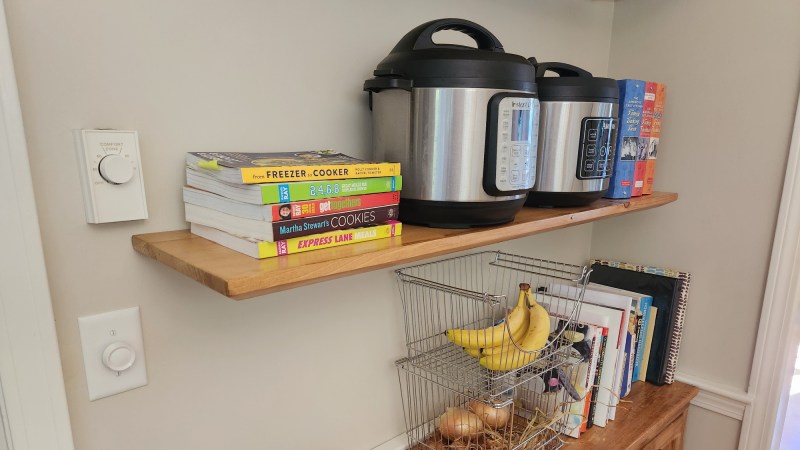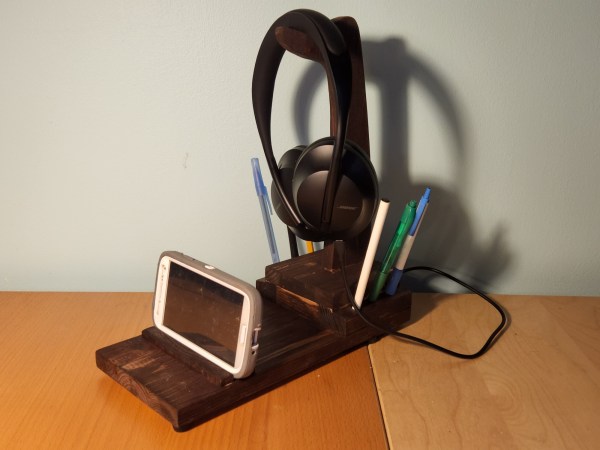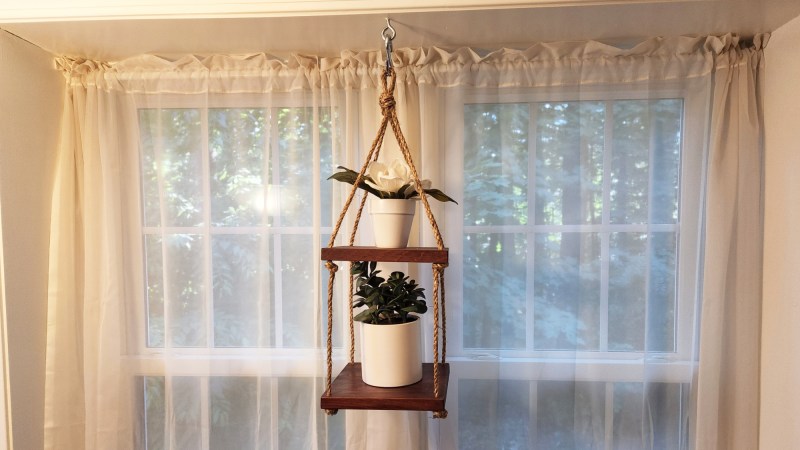

One of the most important skills in woodworking is learning to properly mill the wood. If you don’t have milling tools or are working with boards that are extra wide, you don’t have to give up, and you definitely don’t have to cut a beautiful slab down to a more manageable size. Instead, build a router sled that will let you flatten pretty much anything.
Figuring out how to make a router sled is a straightforward project. Set up two parallel rails a few feet apart, place a board between them, and put a sled on top of the rails for your router to sit in. To use the sled, push the router, equipped with a flattening bit, back and forth, trimming off a thin slice of the board below. Repeat until you’ve surfaced the entire board.
By no means is this the best way to flatten a board. It can take hours, depending on the slab and the size of your router and bit. And boy oh boy does it make a mess. But sometimes it’s the only option available. After all, not many of us have the space, budget, or power supply required to purchase industrial-sized milling equipment.
Various companies sell metal versions of these tools, and they may be a good investment if you do a lot of flattening. However, it’s pretty easy to build a DIY router sled, allowing you to customize it exactly to your needs and space.
Warning: DIY projects can be dangerous, even for the most experienced makers. Before proceeding with this or any other project on our site, ensure you have all necessary safety gear and know how to use it properly. At minimum, that may include safety glasses, a facemask, and/or ear protection. If you’re using power tools, you must know how to use them safely and correctly. If you do not, or are otherwise uncomfortable with anything described here, don’t attempt this project.
Stats
- Time: 1 to 2 hours
- Material cost: $50 to $100
- Difficulty: easy
Materials
- 1 (8-foot) 1-by-6-inch board (or plywood or scrap wood)
- 2 pieces of 36-inch-long angle iron
- Shims
- Hot glue
Tools
How to build a DIY router sled
1. Decide how big you need your router sled to be. This requires some prognostication on your part about what size projects you’re going to build in the future. For end tables, you can probably get away with a sled that’s 2 feet square. For coffee tables, you’ll need something more in the 3-by-4-foot range. And if you’re looking to try your hand at dining tables, you’ll probably need to go 8-by-4 (a full sheet of plywood) for the base.
The most challenging dimension to determine is the height of the rails, which establishes what thickness of board you can flatten. Your rails need to be taller than the board you’re milling, but you can’t make them too tall or your router bit won’t reach low enough to actually touch the top of the slab.
The largest board I’ve flattened has been 4 feet by about 16 inches. I made my rails 5 feet long and 2 inches tall, with a sled that is 36 inches long. I decided on this depth because I’ve never worked with anything deeper than that, and my router can plunge a little over an inch. If I ever need to work with a thicker or thinner slab, I add plywood shims under the rails or board being flattened to raise or lower their relative positions, then secure them with either hot glue. (More details on leveling and shimming in the “Setting up and using the router sled” section below.)
- Pro tip: For more flexibility, I don’t permanently attach my rails to a base, either. I clamp them to my workbench so I can adjust to the width of the board.
2. Mill the lumber so it’s flat and square. Working with flat, square boards is much easier and more accurate than having to deal with warps, waves, and curves. For this project in particular, having straight edges and faces is crucial. Any waves or bows in the rails will transfer onto the surface of the slab that you’re flattening, which defeats the entire purpose of this setup.
[Related: The surprising woodworking tools you already have around the house]
We have a more comprehensive guide to milling lumber if you’re curious, but it’s a simple process. First, flatten one face of the board, on a jointer if you have one. Then trim one edge, making sure it’s perpendicular to the flat face. Next, flatten the remaining face, with a planer if you have one, and trim it to its final width on a table saw. Finally, trim the boards to their final length.
If you’re making your rails out of ¾-inch plywood, which many people do, you don’t need to mill it—simply trim it to the proper width and length.
At the end of the milling process, you should have four boards, just under ¾ of an inch thick:
- 2 that are 4 feet long and 1 ¼ inches wide
- 2 that are 4 feet long and 2 ½ inches wide
3. Glue and screw the boards into an “L” shape. To achieve this shape, stand the long edge of one 1¼-inch-wide board on the face of one 2½-inch-wide board. Align the two boards so the edge of the bottom piece is flush with the face of the top one, and glue them in place, securing them with clamps. You can also use a countersink bit and 1½-inch wood screws to hold the boards together while they dry. Repeat this step with the other two boards.
4. (Optional) Cut eight small 1-by-1-inch squares of scrap wood on your table saw or miter saw. These will add stability to your rails and keep them from warping over time. The best way to do this is with a crosscut sled on your table saw, which is my preferred method. You can also use a miter saw or hand saw if you’re more comfortable with those. Then glue and screw four of these along the length of each rail to hold the 90-degree orientation of the “L.” With that, the rails are done.

5. Cut two spacer blocks that are slightly wider than the base of your router. These spacers can be made from whatever wood you have lying around, and don’t need to be perfectly flat or square. They should all be the same width, though, about ⅛-inch wider than the base of your router. Cut these out on your table saw, miter saw, or with a hand saw—whichever tool is handiest for you.
- Note: If you have more than one router, use your most powerful one in the sled. I’ve tried flattening with my 1.25-horsepower DeWalt palm router, and while it can technically do the job, it struggles. My fixed-base Craftsman is more powerful and much more suited to the task, even if it’s not quite as easy to use and adjust.
6. Clamp the spacer blocks between the pieces of angle iron. This will be the actual sled your router sits on. Put one spacer block at each end of the metal bars, resting on the inside lip. Then clamp them in place. I clamp rather than using screws or glue for a couple reasons. First, I have more than one router, which means I might decide to use a different one. To swap, all I need to do is cut a new spacer and put it in place, rather than having to build a new sled. Second, clamps allow me to store the sled disassembled, which takes up a lot less space in my teeny, tiny basement shop.
[Related: Build a semi-permanent work surface you can put away easily]
Once the iron sled is set up and the rails are dry, you’re ready to start flattening.
Setting up and using the router sled
1. Position the rails. Set your rails on your workbench, spaced far enough apart so the board you’re flattening can fit between them with a couple of inches to spare on either side. Depending on your setup, you can either clamp these down or screw them in place.

2. Level and secure the board between them. The surface of the board should be just below the top of the rails, so the router bit can easily reach it. You also want to do your best to get that top surface approximately level with the plane formed by the top of the boards. This will reduce the amount of material that needs to be removed in order to flatten it. Shim the board to the proper alignment, then hot glue those shims—and the board—in place. If the board moves at all while you’re routing, you may not end up with a flat surface.
- Pro tip: If the board is particularly warped or tapered, try to position the board so you’ll take the least amount of material off each side. This takes some guesswork and experimentation, and it’s not absolutely critical, but I always try to save as much wood as possible.
3. Place the angle iron sled on top of the rails. The sled should lay perpendicular to the rails and across both. Position it to the left or right of the board, then slide it back and forth along the length of the rails to double check that it doesn’t bump into anything as you go. Getting hung up on a clamp or the corner of the board while you’re routing is really annoying. Adjust as needed.

4. Start routing. Secure your slab-flattening bit into your router, drop the router into the sled, and start routing. With the depth set to take off between a sixteenth and eighth of an inch, push the router across the board, holding it secure. Don’t allow the tool to tip forward or backward, or you’ll gouge the wood. Pull the router back to you along the sled, slide the whole apparatus over about two-thirds the width of your bit, and push the router forward again. Keep going until you reach the end of the board.
If you didn’t flatten the entire surface in one path, lower the bit between a sixteenth and eighth of an inch and repeat the process. Keep going until you’ve flattened the entire face of the board.
Once you complete your last pass, flip the board over, secure it to your workbench, and do it all again on the other face.
And make sure to keep the shop vac handy. You’re going to make a massive mess, and you’ll need to clean up periodically to be able to see what you’re doing.
When the board’s smooth, all that’s left is endless sanding to get the router marks out of the wood.
Sure, it’s not the fastest or easiest way to flatten a board. But sometimes, it’s the only option you have, and it gets the job done.















